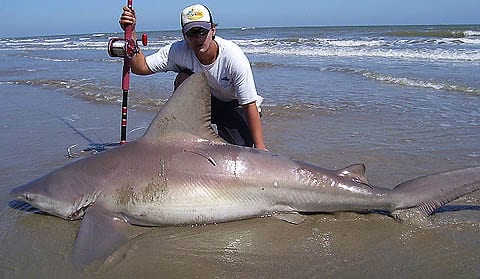 These guys take the term “fishing for bites” to the extreme.
These guys take the term “fishing for bites” to the extreme.
With the help of recreational anglers, researchers at the Harte Research Institute in Corpus Christi are out to catch sharks — the bigger the better — and tag them to track migration patterns and study growth.
Understanding shark behavior can help benefit saltwater fisheries as a whole, said Dr. Greg Stunz, Endowed Chair for Fisheries and Ocean Health at the Harte Research Institute.
“Predators are important to keep marine species in check,” Stunz said. “But you still need more wildebeests than you do lions.”
The absence of data makes it hard to know how to best manage the different shark species, which is essential to preserve healthy populations.
“Sharks are very important and play an important part in the ecosystem,” he said. “There is a real serious lack of data with what we know about sharks, particularly along the Texas Coast.”
There are three different types of tags; passive, acoustic and satellite.
The passive tag is placed on every shark caught and costs about $2. These tags simply have a phone number and a Web page listed so the angler can report the tag.
The acoustic tags are surgically implanted and give information when the shark swims within a half mile of the institute’s network of hydrophones, and carry a cost of a few hundred dollars.
The satellite tags relay information more continually, cost around $5,000 each, and are designed to separate from the shark after six months.
“All this together gives us a good picture and makes sure they’re around for recreational anglers for years to come,” Stunz said. “We work very closely with recreational anglers and we have kits they can get from us and then go to our Web page and upload numbers from the shark.”
Philip Jose, a graduate student in charge of the shark-tagging project at Texas A&M Corpus Christi, said working with recreational anglers helps the research tremendously.
“We spend a lot of time on the piers because there’s so many people fishing,” he said. “We’ll go over and ask if they want us to get the shark off the hook for them — there’s teeth flashing everywhere — and they’re like…’yeah.’”
Once it comes time to tag the shark, there is some finesse involved, as the tag is placed at the base of the dorsal fin.
“It’s really sort of an art form,” Jose said. “It’s like trying to punch through leather, and then it’s like putting a hot knife through butter, so you have to be real careful.”
When dealing with sharp-toothed fish, the taggers always have to stay in control and be mindful of what they’re dealing with.
“You have to be careful because they know when you’re starting to let up so they’ll kick, and try to take a piece of you while you’re trying to take a piece of them.”
Keith Long of Burleson is one of the recreational anglers who catches sharks to tag along the Galveston area beaches.
“I was fishing for sharks for 3 to 4 years before I started tagging,” he said. “I’ve tagged probably 100 or so.”
Even in the few years since he has started tagging, enough information has been gathered to better understand patterns of the sandbar shark, which is labeled as “near threatened” by the International Union for Conservation of Nature.
“They’ve started picking up a migration pattern going through Texas,” he said.
Long said the tagging is a free program anyone can do, and having a partner to help is valuable.

